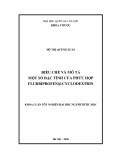
JST: Engineering and Technology for Sustainable Development
Volume 35, Issue 1, March 2025, 009-016
9
Optimization of the Slowly Digestible Starch Formation from
Edible Canna Starch Modification with Beta Cyclodextrin
Nga Luong Hong1, Thuy Vu Thi Thu1, Bang Luong Van1, Nam Vu Hoang1,
Anh Ngo Thi Hoai1, Khoi Nguyen Truong2, Son Vu Hong1*
1Hanoi University of Science and Technology, Ha Noi, Vietnam
2Colleges of Biological Sciences, University of Minnesota, Twin Cities, America
*Corresponding author email: son.vuhong@hust.edu.vn
Abstract
Slowly digestible starch is the starch fraction that is digested at a slow rate in the body, meaning it is broken
down by the digestive enzyme in human body during 20 to 120 min. after eating. Recently, slowly digestible
starch (SDS) and resistant starch (RS) are widely studied worldwide because of their various positive health
effects: releasing glucose at a slow rate, thereby maintaining sufficient blood glucose, glycemic index and
insulin levels, reducing the risk of Type II diabetes, etc... The goal of the research was to identify the optimal
conditions for maximizing the production of SDS from edible canna starch by using β-cyclodextrin with four
factors examined: water content, β-cyclodextrin content, reaction temperature, and reaction time. When
amylose in starch interacts with β-cyclodextrin through their hydrophilic shells, amylose-β-cyclodextrin
(amylose-β-CD) and amylose-β-CD-lipid complexes are formed. These complexes exhibit a V-type crystalline
structure characterized by low stability. It facilitates an increase in the production of SDS. The results showed
that with a water content of 81.3%, β-cyclodextrin content of 3.1%, reaction temperature of 36 oC, and reaction
time of 1.8 hours, the SDS content was obtained from edible canna starch up to 44.88%.
Keywords: Edible canna starch, slowly digestible starch, optimization, β-cyclodextrin, SDS.
1. Introduction1
Starch is a complex carbohydrate found in many
foods, particularly in cereals such as wheat, rice, and
corn, as well as in potatoes and other starchy roots.
Starch occurs widely in nature and is the second largest
biomass on earth after cellulose and one of the most
abundant bio-renewable materials. The properties of
native starch do not always meet the requirements for
a multitude of industrial applications [1]. Based on the
rate and extent of digestion, starch can be classified
into 3 types: rapidly digestible starch (RDS), slowly
digestible starch (SDS) and resistant starch (RS), which
were first introduced by H. Englyst et al. (1992) [2] to
reflect the rate of starch digestion in vivo. The starch
fraction digested within 20 min of incubation is
classified as RDS; the starch fraction digested within
20 - 120 min corresponds to SDS; and the remaining
fraction, which is not digested further, is RS. This
value may be an underestimation, as some starches
were considered to take closer to 4 h to pass out of the
small intestine [3-4].
SDS refers to a starch fraction with a slow
digestion rate in the small intestine. SDS has the
potential to ensure stable postprandial glucose
metabolism, lower the risk of diabetes, and also ensure
superior mental and physical performance in terms of
ISSN 2734-9381
https://doi.org/10.51316/jst.180.etsd.2025.35.1.2
Received: Jul 26, 2024; revised: Nov 21, 2024;
accepted: Dec 16, 2024
health effects on the human body [5]. Foods containing
SDS could cause an improvement in the carbohydrate
metabolism and facilitate a concomitant reduction in
the insulin requirements of insulin-treated type 2
diabetes mellitus (T2DM) patients [6-7].
There were several ways to form SDS from
starch. Physical modifications include hydrothermal
(heat-moisture and annealing), microwave, ultrahigh
pressure (UHP), irradiation, and ultrasonic treatment
[8]. Chemical modifications are mostly practiced for
food starches, generally by derivatization such as
etherification, esterification, cross-linking,
oxidization, and acid hydrolysis of starch. Enzymatic
modification mainly involves treatment of starch using
hydrolyzing enzymes [9]. Among those, physical
methods were considered more natural and were safe.
The physical modification methods used to produce
SDS included hydrothermal, autoclaving,
microwaving, and polymer entrapment methods as
well as using β-cyclodextrin.
β-cyclodextrin (β-CD) is a cyclic and non-
reducing functional oligosaccharide that consists of
D-glucose units with a-1,4 glycosidic bonds in a
doughnut-shaped ring. [10] Its aperture, with its
hydrophobic core, can form inclusion complexes with
small organic and inorganic molecules in aqueous









